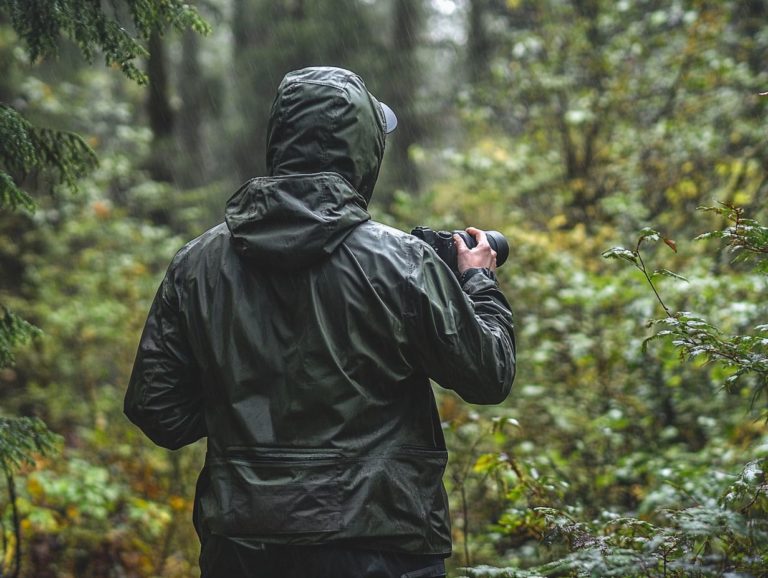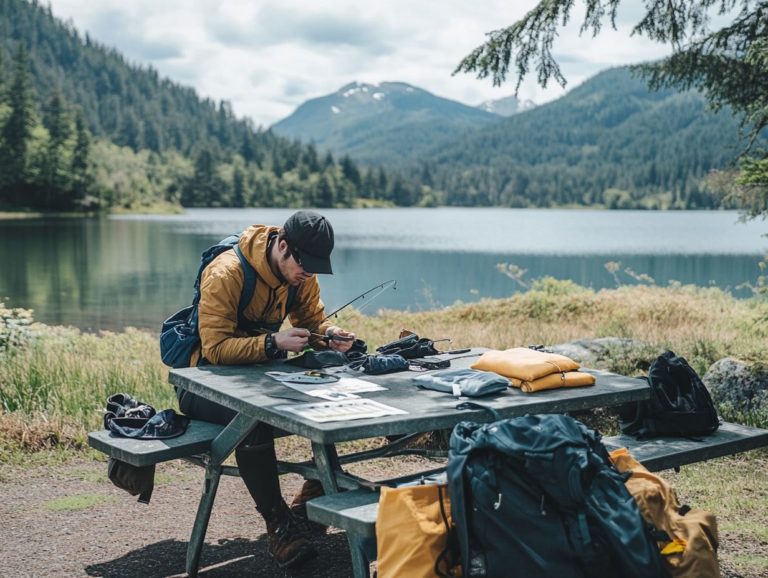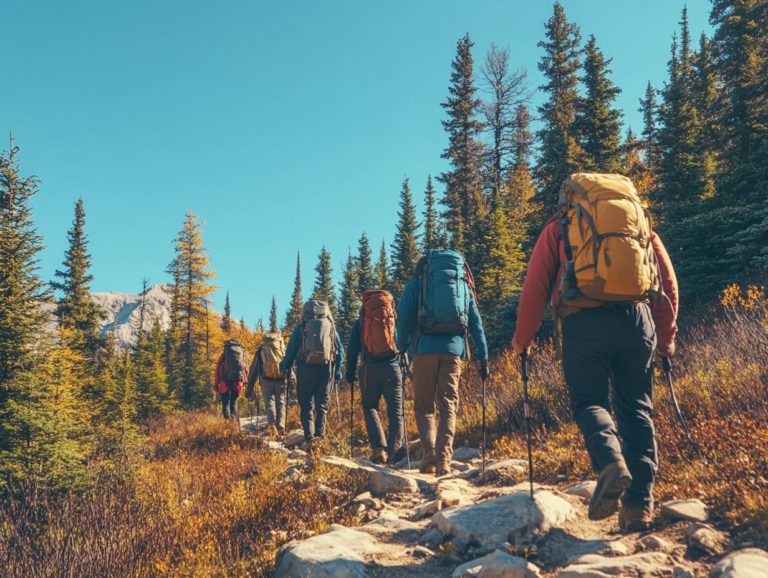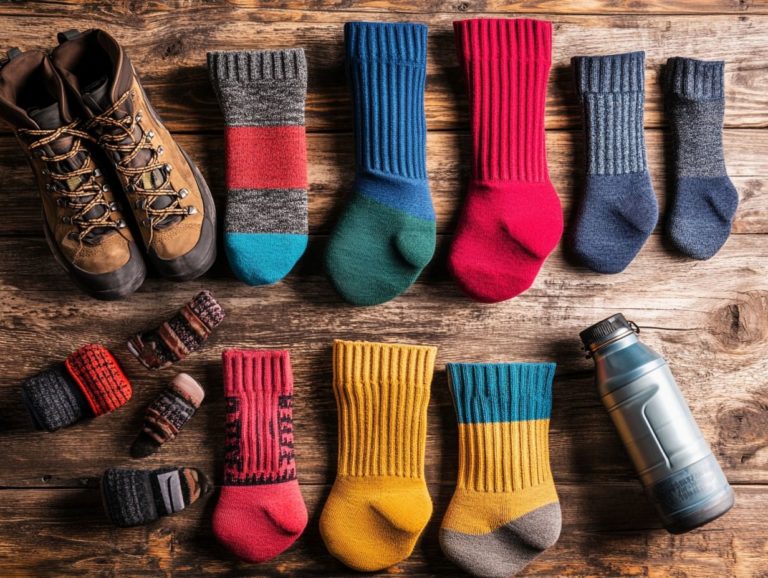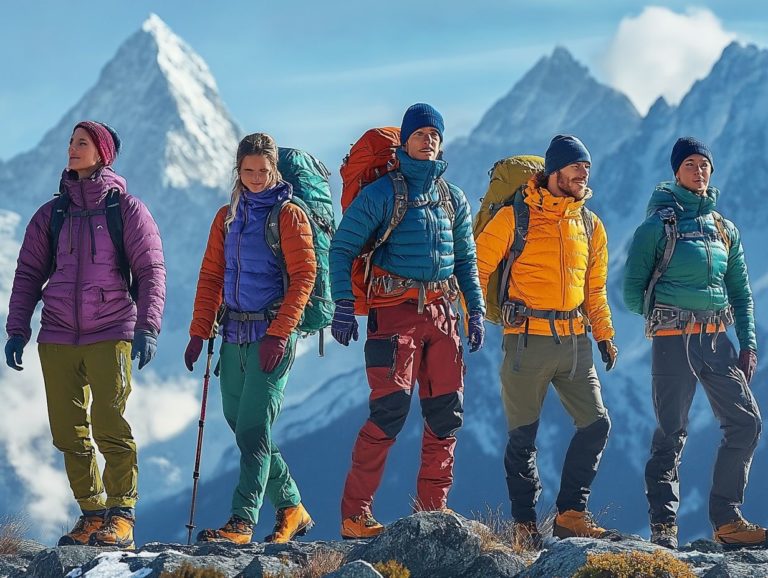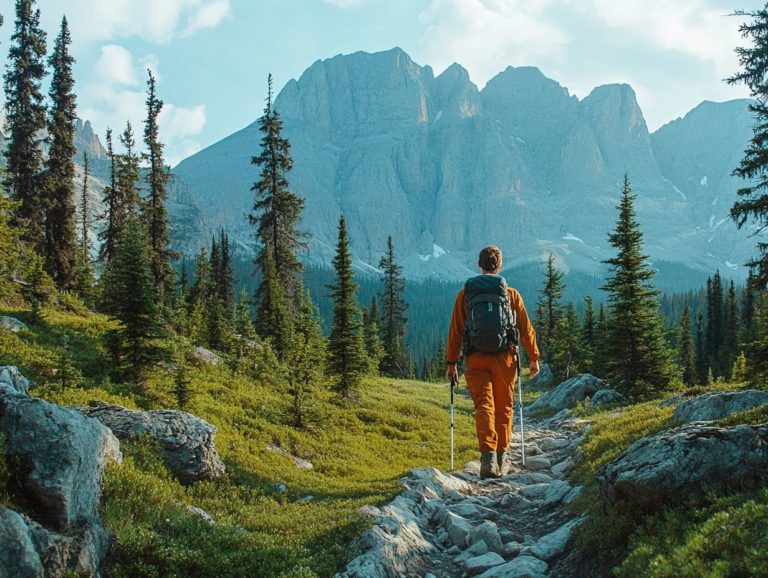What to Wear for a Multi-Day Hiking Trip
Planning a multi-day hiking trip? The right clothing and gear can significantly enhance your comfort and enjoyment on the trail, making every hiking experience memorable.
Master the layering system for optimal air flow, and choose well-fitting hiking boots. Every decision you make carries weight, especially when considering the load and its impact on your hiking performance.
Think about protective gear, essential accessories, and effective packing strategies to easily navigate changing weather conditions and diverse terrain.
Get ready to gear up! This guide will equip you with everything you need for an unforgettable adventure, whether you re planning a camping trip or a backpacking trip.
Contents
- Key Takeaways:
- Essential Clothing for a Multi-Day Hiking Trip
- Footwear for Hiking
- Protective Gear and Accessories
- Factors to Consider When Packing Clothing
- Tips for Packing Efficiently
- Frequently Asked Questions
- What type of footwear is recommended for a multi-day hiking trip?
- What type of clothing should I pack for a multi-day hiking trip, including essential items for performance durability?
- How should I dress for a multi-day hiking trip in warmer weather?
- What type of backpack should I use for a multi-day hiking trip?
- Do I need to bring any specialized gear for a multi-day hiking trip?
- How should I prepare my clothing for a multi-day hiking trip?
Key Takeaways:
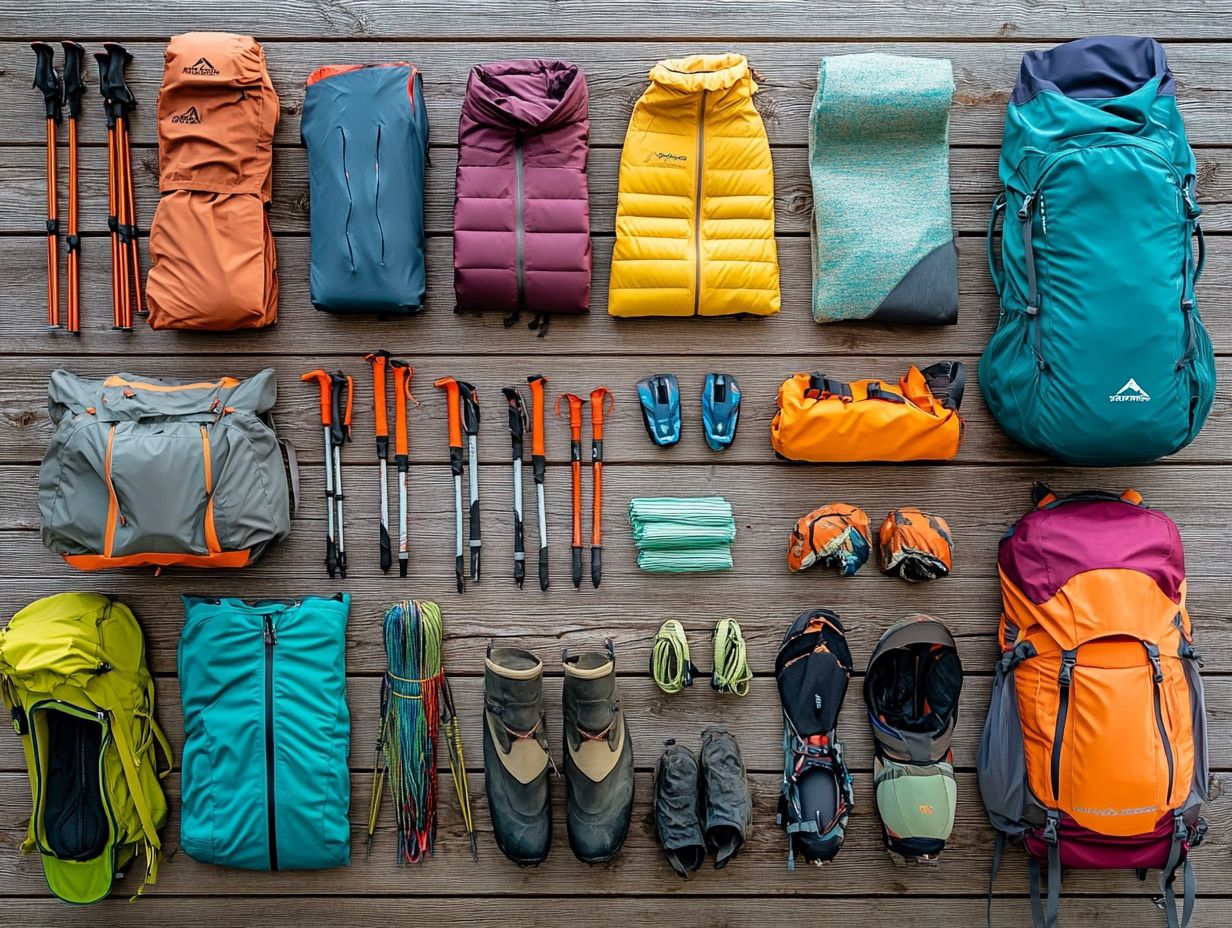
- Layering is key for a multi-day hiking trip. Choose breathable clothing like merino wool and moisture-wicking materials to help regulate your body temperature and prevent overheating.
- Proper footwear is essential for a comfortable and safe hiking experience. Consider the terrain and duration of your trip when choosing the right hiking shoes or boots.
- Don’t forget to pack protective gear and accessories, such as sun protection, insect repellent, and a well-stocked first aid kit. These will help you avoid discomfort and potential health risks during your hike.
Essential Clothing for a Multi-Day Hiking Trip
When you set out on a multi-day hiking trip, choosing the right clothing greatly influences your comfort, safety, and overall experience on the trail.
Opting for the right materials and construction in your hiking attire can enhance air flow and moisture management, especially as you encounter diverse weather conditions and varying terrains. This ensures you remain dry and comfortable throughout your adventure.
Investing in a quality base layer made of merino wool or synthetic fabrics creates a reliable foundation for your layering system, providing essential insulation and warmth when temperatures drop.
Layering System and Importance of Air Flow
A well-structured layering system is crucial for your hiking experience. It allows you to adapt seamlessly to changing weather conditions while maintaining optimal comfort levels throughout your trek.
The foundation of this system is the base layer, designed to wick moisture away from your skin while providing a snug, comfortable fit. This moisture management is vital; it prevents chilling in cold weather and keeps you dry from sweat.
Next, the insulation layer acts as a barrier against the cold while retaining your body heat. This layer can vary in thickness and materials, ranging from lightweight fleece to more robust down options, offering versatility tailored to the temperature.
Finally, the outer layer defends against wind, rain, and other elements. This highlights the importance of air flow to prevent overheating. By understanding how each layer works together, you can ensure your comfort and performance in various environments.
Footwear for Hiking
Choosing the right footwear for hiking is essential, as it greatly impacts your stability, comfort, and overall performance on the trails, whether you’re navigating rugged terrains or enjoying a leisurely stroll.
With a wide array of options available, from durable hiking boots built to handle heavy loads to lightweight trail-running shoes that enhance your agility and speed, you have plenty to consider.
Renowned brands like Salomon and Merrell offer outstanding choices, ensuring you discover the perfect fit that prioritizes both comfort and protection for your hiking adventures.
Start planning your adventure today!
Types of Hiking Boots and Choosing the Right Fit
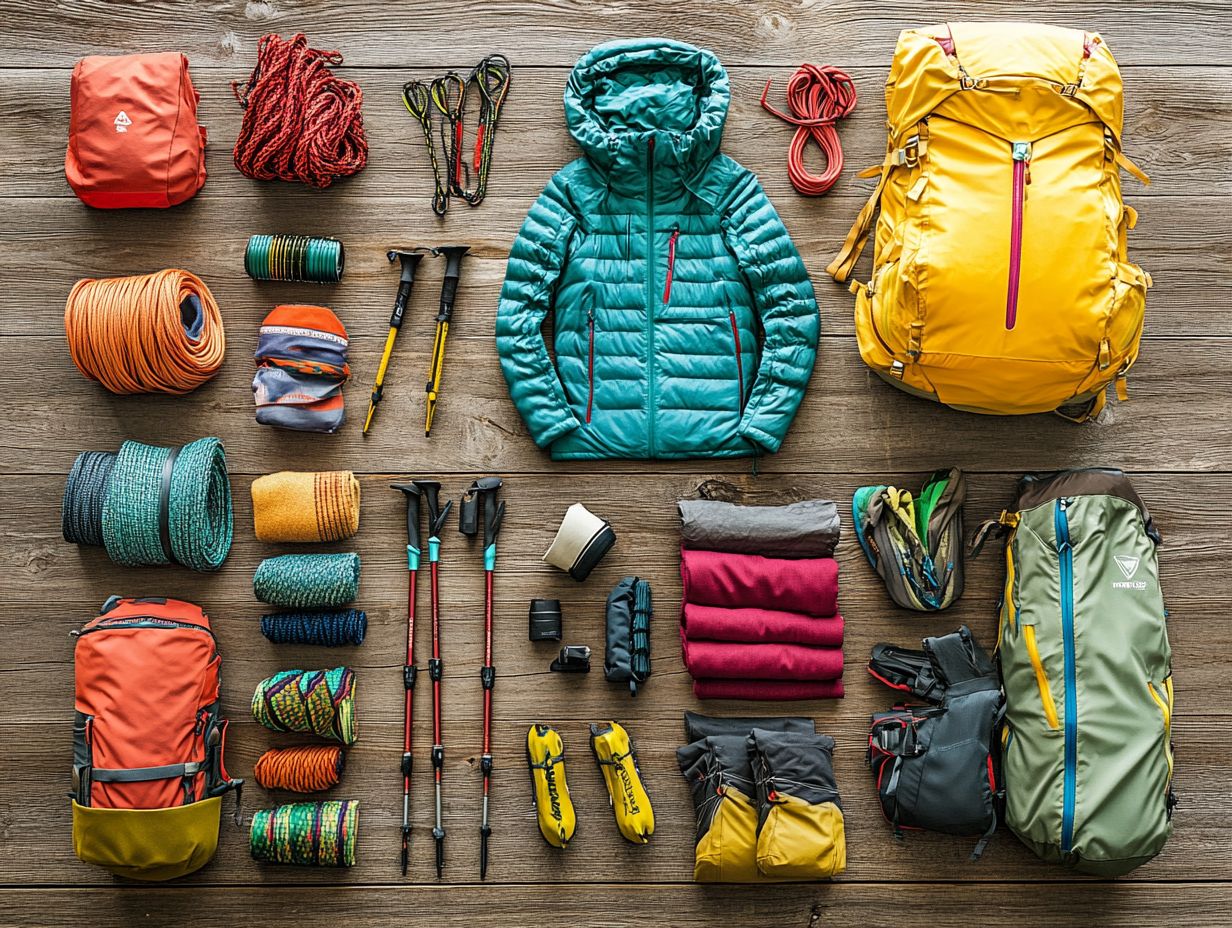
In terms of hiking boots, understanding the various types available and selecting the right fit is essential for ensuring the best performance, durability, and comfort during your outdoor adventures.
You often find yourself weighing the choice between lightweight models, tailored for agility and speed, and heavy-duty options, designed to provide robust protection in challenging terrains.
Lightweight hiking boots offer breathability and flexibility, making them ideal for day hikes or well-maintained trails. On the other hand, heavy-duty boots shine in rugged environments where ankle support and extreme durability are critical.
To guarantee the best fit, be sure to try on the boots with the specific type of hiking socks you plan to wear on your excursions. This practice ensures comfort by accommodating proper sock thickness and helps prevent blisters, allowing you to fully enjoy your hiking experience.
Protective Gear and Accessories
Protective gear and accessories are essential for ensuring a safe and enjoyable hiking experience. They provide crucial protection against the elements and any potential hazards you may encounter on the trails.
Sun Protection, Insect Repellent, and Other Must-Haves
For your hiking trip, consider packing essential items like sun protection, insect repellent, and a well-stocked first aid kit. These must-haves are crucial for enhancing your safety and comfort on the trail.
These essentials shield you from the sun’s harsh rays, which can lead to painful sunburns and long-term skin damage. They also fend off pesky insects that can ruin your outdoor experience.
Opting for UV-blocking clothing and a wide-brimmed hat adds an extra layer of protection against harmful UV exposure. Effective insect repellent is a must to keep those nuisances at bay, alongside your essential items for safety equipment.
A comprehensive first aid kit is critical for addressing minor injuries. Hydration solutions ensure you stay properly hydrated keeping your energy levels up as you conquer the terrain.
Factors to Consider When Packing Clothing
Consider these key factors to ensure you re ready for an amazing adventure! Analyze the weather, understand the terrain types, and assess the duration of your trip.
By doing so, you can select the right clothing and gear that will not only enhance your comfort but also minimize any potential risks. Utilizing a comprehensive hiking checklist will ensure you don’t overlook any essentials, like clothes that keep sweat away and versatile hiking pants, all tailored to elevate your hiking experience.
Weather, Terrain, and Trip Duration
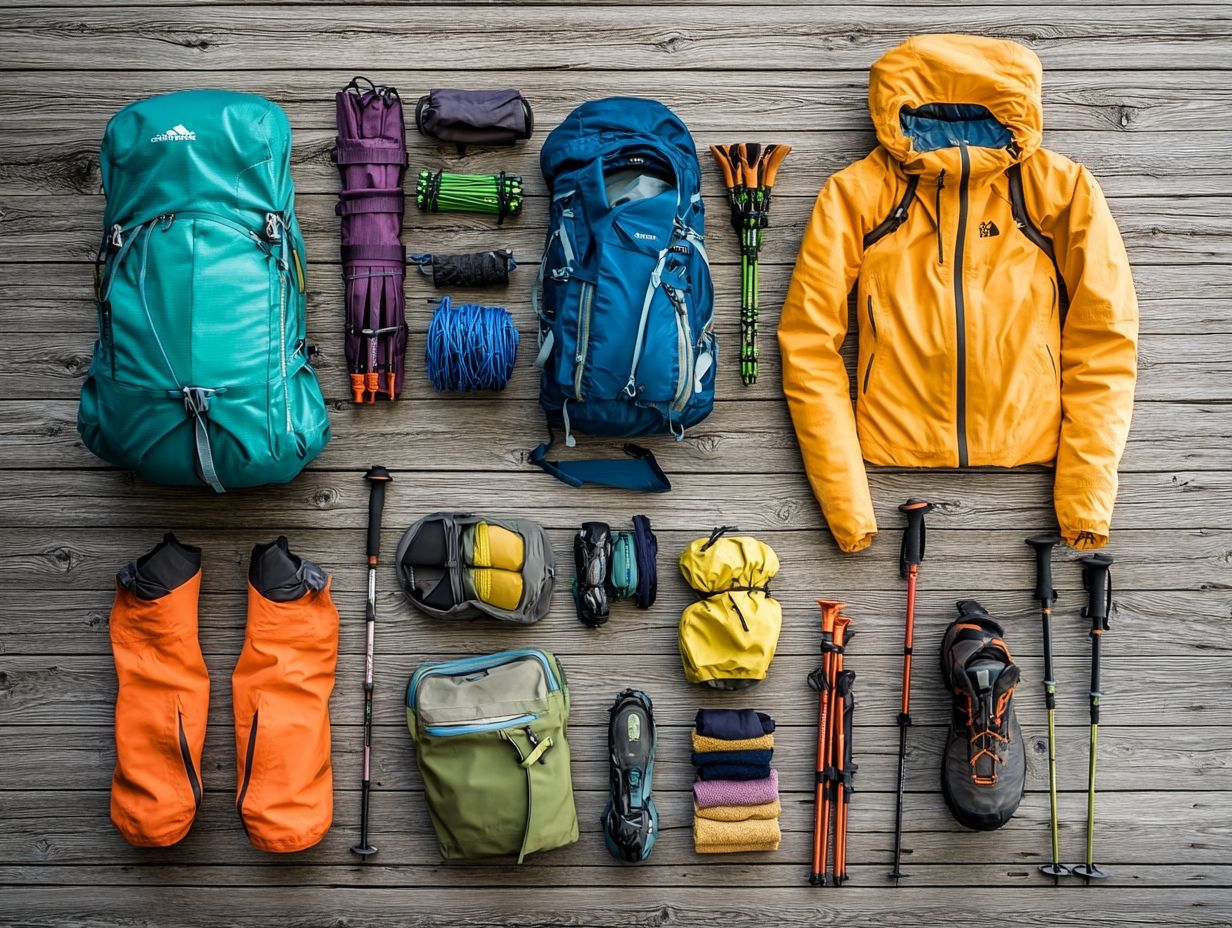
Understanding the weather conditions, terrain types, and trip duration is essential for determining the right clothing and gear for your hiking experience.
By thoughtfully considering these factors, you can develop a tailored packing strategy that elevates your comfort and performance on the trail. For example, if the forecast calls for rain, waterproof jackets and clothes that keep sweat away become critical for staying dry and regulating your body temperature.
When navigating rocky or uneven terrain, it s wise to prioritize sturdy hiking boots with excellent ankle support to prevent injuries.
The length of your hike also influences your clothing choices. For longer excursions, packing extra layers ensures you stay warm at night. Lightweight, breathable fabrics are perfect for daytime trekking to avoid overheating.
By taking a careful approach to these key elements, you’ll set yourself up for a more enjoyable and safe outdoor adventure.
Tips for Packing Efficiently
Ready for your next hiking adventure? Packing efficiently can make all the difference! Packing for a multi-day hiking trip is crucial for minimizing the weight of your load. This can significantly enhance your overall experience and enjoyment on the trail.
By opting for lightweight gear options like the Osprey Atmos AG or the Ultralight Stuff Pack, you ll carry only the essentials, optimizing both comfort and mobility.
Smart packing strategies reduce strain while allowing you to enjoy the beautiful landscapes you traverse.
Maximizing Space and Minimizing Weight
To maximize space and minimize weight in your hiking backpack, employing effective packing techniques is essential for achieving a well-balanced load that enhances your hiking experience.
Utilizing tools like compression bags allows you to significantly reduce the volume of bulky clothing and gear, enabling smarter organization. By placing heavier items toward the bottom, you can improve stability and ensure even weight distribution.
Rolling your clothes minimizes air pockets and saves space. It s wise to reassess the necessity of each item; shedding unnecessary bulk can result in a more comfortable trek.
Being mindful of these packing techniques lightens your load and boosts your overall efficiency during the adventure.
Frequently Asked Questions
What type of footwear is recommended for a multi-day hiking trip?
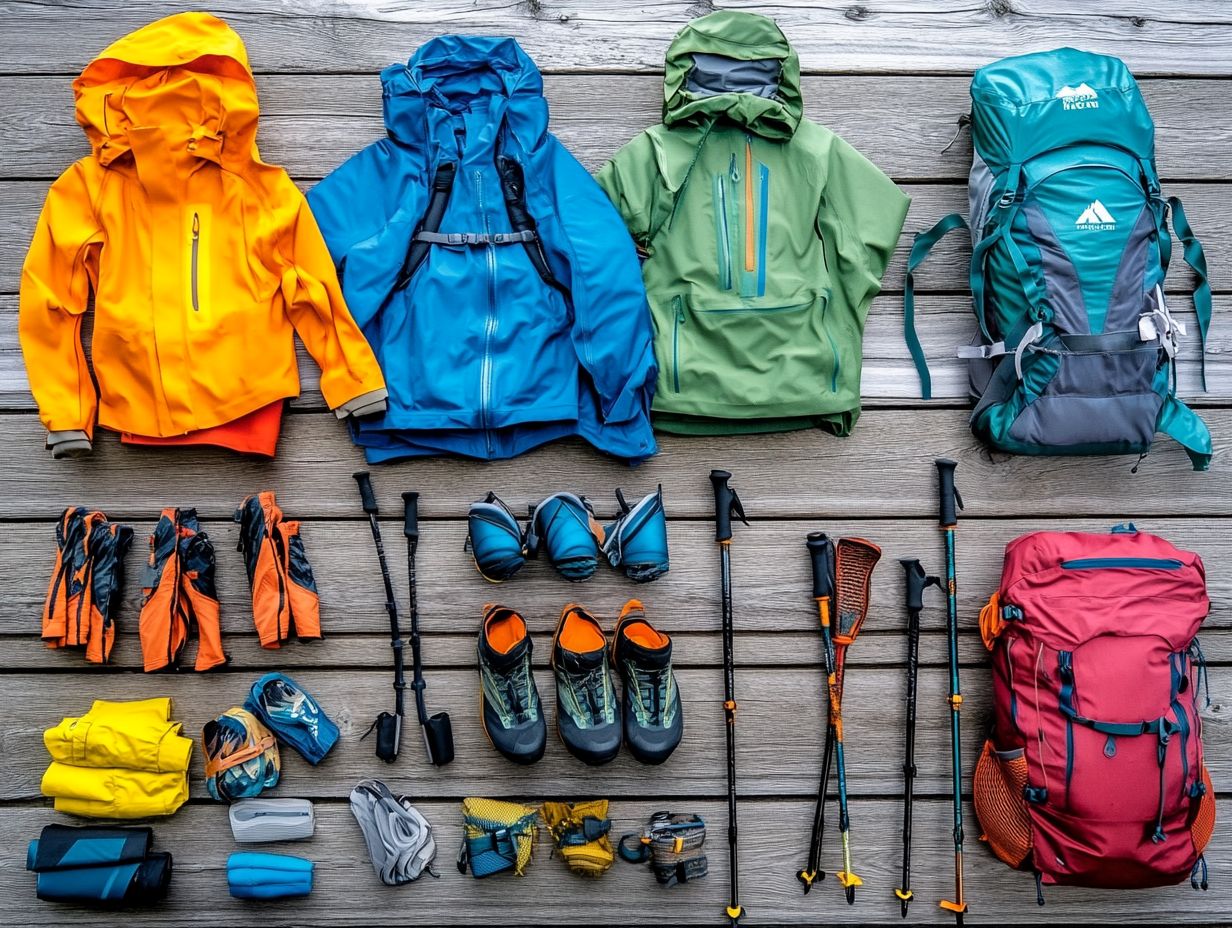
For a multi-day hiking trip, it is important to wear sturdy, comfortable, and waterproof hiking boots or trail-running shoes. These provide proper support to your feet and ankles, protect against rugged terrain, and are essential for preventing blisters and injuries.
What type of clothing should I pack for a multi-day hiking trip, including essential items for performance durability?
When packing for a multi-day hiking trip, be sure to bring layers that can be easily added or removed as needed, including fabric that keeps you dry and lightweight gear. Essential items include insulating mid-layers and a waterproof outer layer, as well as reliable performance hiking clothes like merino wool. Don’t forget extra socks, gloves, and a warm hat for colder temperatures.
How should I dress for a multi-day hiking trip in warmer weather?
In warmer weather, choose lightweight and breathable clothing, such as hiking pants and shirts made from synthetic fabrics, to prevent overheating and discomfort. Opt for moisture-wicking fabrics, loose-fitting clothing, and a wide-brimmed hat for sun protection. Consider adding hiking accessories like sunglasses, and pack a lightweight rain jacket, a first aid kit, and safety equipment for unexpected showers.
What type of backpack should I use for a multi-day hiking trip?
A sturdy and comfortable backpack, such as the Osprey Atmos AG or a Kelty Cosmic Down, is essential for a successful multi-day hiking trip. Look for a backpack with proper padding, adjustable straps, and a hip belt for effective weight distribution. Choose a size appropriate for the length of your trip, factoring in backpacking guidelines, and ensure it has enough room for all your necessary gear.
Do I need to bring any specialized gear for a multi-day hiking trip?
It is recommended to bring specialized items for a multi-day hiking trip, such as a water filtration system, a headlamp, trekking poles, and a personal locator beacon. These items can make your trip more convenient and comfortable, especially when water sources are scarce or when hiking in low light conditions.
Have more questions? Let us know in the comments below!
How should I prepare my clothing for a multi-day hiking trip?
Prepare your clothing in advance using a hiking checklist. Wash and dry all items. Break in new hiking boots and consider wearing a soft, breathable fabric made from merino sheep for comfort.
Properly preparing your clothing can make or break your hiking experience. Don t overlook these crucial steps!

